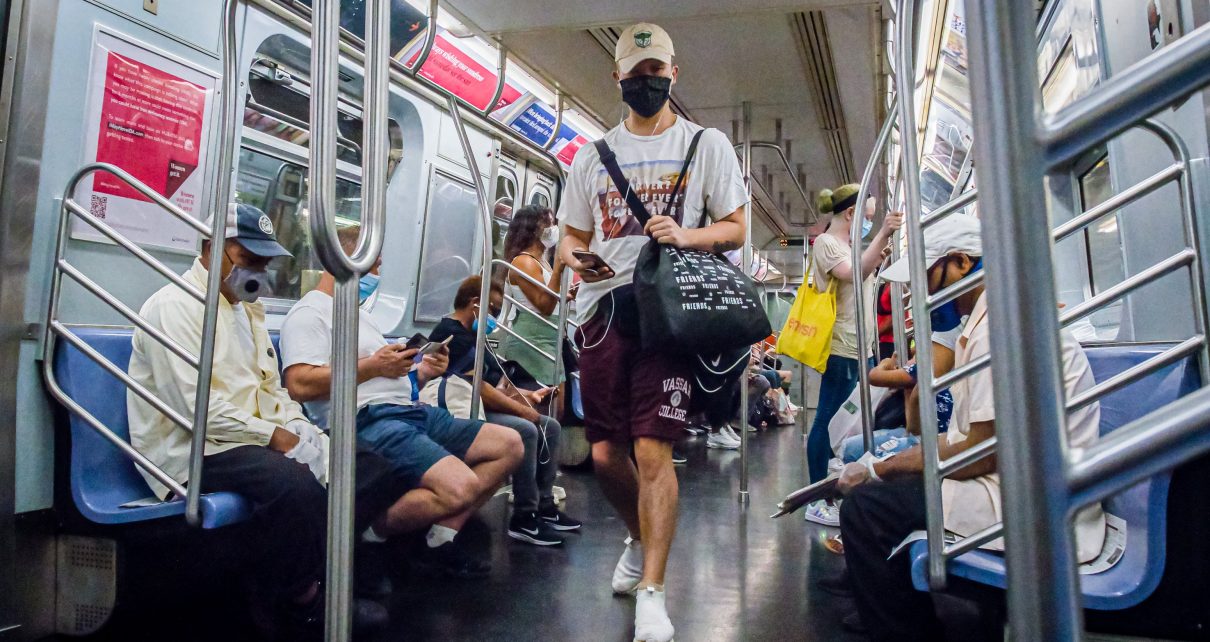In the early months of the COVID-19 pandemic, Ben Fried made a difficult decision: He stopped riding New York City’s subway system.
He was not alone. Ridership on the city’s notoriously packed commuter trains dropped 92% in mid-April, when New York emerged as an epicenter of the global health crisis.
For Fried, the decision was especially tough because he serves as communications director for TransitCenter, an advocacy group that touts the environmental benefits of mass transit.
But as the virus spread, those benefits were overshadowed by the risk of contagion in the enclosed spaces of subway cars.
“I think the prevailing attitude then was, ‘If you don’t need to ride, don’t ride,’” Fried recalled in a recent phone interview.
Since those first fateful months, however, Fried has ventured back onto the subway with his wife. And he’s become part of a vocal group of advocates saying the initial fears of mass transit were overblown.
Those advocates say there is scant evidence tying major coronavirus outbreaks to buses and trains. On the contrary, they say, transit can play a crucial role in the pandemic era by reducing air pollution that makes people more susceptible to COVID-19.
Two prominent proponents of this argument are Janette Sadik-Khan, the former commissioner of the New York City Department of Transportation, and Seth Solomonow, the co-author of “Streetfight: Handbook for an Urban Revolution.”
In a recent opinion piece in The Atlantic titled “Fear of Public Transit Got Ahead of the Evidence,” the pair wrote that “many have blamed subways and buses for coronavirus outbreaks, but a growing body of research suggests otherwise.”
The piece noted that epidemiologists use the term “cluster” to describe major coronavirus outbreaks. A cluster is defined as more than three cases that can be traced to a common event or venue, excluding transmission within households.
In Paris, a recent study found that none of the city’s 150 coronavirus clusters from early May to early June originated on the city’s transit systems, Le Parisien newspaper reported.
The study was conducted by researchers at Santé Publique France, the national public health agency. It was published June 4.
“Indeed, on that date no transport clusters were identified,” Marie Delibéros, a spokeswoman for the agency, said in an email to E&News.
As of July 15, four transport clusters had been identified in Paris, accounting for roughly 1% of 386 total clusters, Delibéros said.
It’s a similar situation in Japan, where researchers failed to connect a single cluster to the country’s commuter trains, said Hitoshi Oshitani, a virologist and public health expert at Tohoku University.
The vast majority of the clusters were instead traced to gyms, bars, live music venues, karaoke rooms and similar establishments where people come in close contact with one another, Oshitani said in an email to E&E News.
‘Reducing the risk’
The evidence is less robust in the United States, which lags other developed countries in contact tracing and coronavirus testing.
Contact tracing involves determining an infected person’s “close contacts,” which the Centers for Disease Control and Prevention defines as “any individual within six feet of an infected person for at least 15 minutes.”
Epidemiologists interviewed for this story couldn’t point to comparable research on contact tracing that focused on U.S. transit systems.
The epidemiologists also were unsure whether riding transit in America was riskier than other activities amid the pandemic, such as going to the gym or eating at a restaurant with outdoor seating.
“How risky is it? Well, there’s nothing in life that doesn’t have risk. And in the COVID era, everybody is trying to assess what risks they’re willing to take,” said Ruth Collins, associate professor of molecular medicine at Cornell University.
It’s difficult to classify the danger of any activity during the pandemic given the lack of robust data, Collins said. But in general, she noted, riding transit is much safer if all passengers are wearing face masks that cover their noses and mouths.
Melissa Perry, a leading epidemiologist and chair of the Department of Environmental and Occupational Health at George Washington University’s Milken Institute School of Public Health, agreed with this assessment.
“When you have universal adherence and compliance with mask use, that’s when you are majorly reducing the risk for transmitting the virus,” Perry said.
Both mask wearing and physical distancing—or keeping 6 feet apart from fellow passengers—are the most important considerations, she said. They take precedence over cleaning and disinfecting surfaces, which are much less likely to spread the coronavirus than respiratory droplets, according to the CDC.
Still, transit poses the risk of “high-touch surfaces” such as handrails and elevator buttons that “a lot of people have touched before you,” Perry said.
“Not all surfaces are created equal,” she said. “With the standard surface—let’s say you pick up an item in the grocery store or get a box in the mail—the likelihood of getting COVID-19 is very low. With public transportation, what we’re talking about is high-touch surfaces. And those are higher-risk surfaces.”
Climate concerns
Regardless of its relative safety, transit can play a crucial role in combating climate change and air pollution, advocates said.
Public transportation produces far less greenhouse gas emissions per mile than cars, according to findings released by the Department of Transportation under President Obama. Leading the pack are subways, which boast 76% less carbon emissions than the average vehicle carrying a single person.
In addition to planet-warming pollution, transit also produces fewer criteria air pollutants such as particulate matter and nitrogen dioxide.
Recent research from Harvard University, which has not yet been peer-reviewed, found a tentative link between higher exposure to particulate matter and higher mortality rates from COVID-19, particularly among communities of color (Greenwire, April 7).
“Shared transportation is so critical to keeping cities congestion-free. And congestion exacerbates the air quality issues that are such a huge part of the calculus of the public health crisis now,” said Brianne Eby, a senior policy analyst at the Eno Center for Transportation, a Washington-based think tank.
Fried, the communications director for TransitCenter, agreed.
“If everyone who has a car starts to drive instead of taking the train or the bus, then particulate emissions are going to rise, and that’s going to exacerbate a lot of the health disparities that have hit communities of color especially hard during COVID,” Fried said.
“And then there’s the long-term climate risk associated with rising carbon emissions,” he added. “So if we see a big shift from transit to driving, that’s going to put climate goals out of reach.”
Reprinted from Climatewire with permission from E&E News. E&E provides daily coverage of essential energy and environmental news at www.eenews.net.



